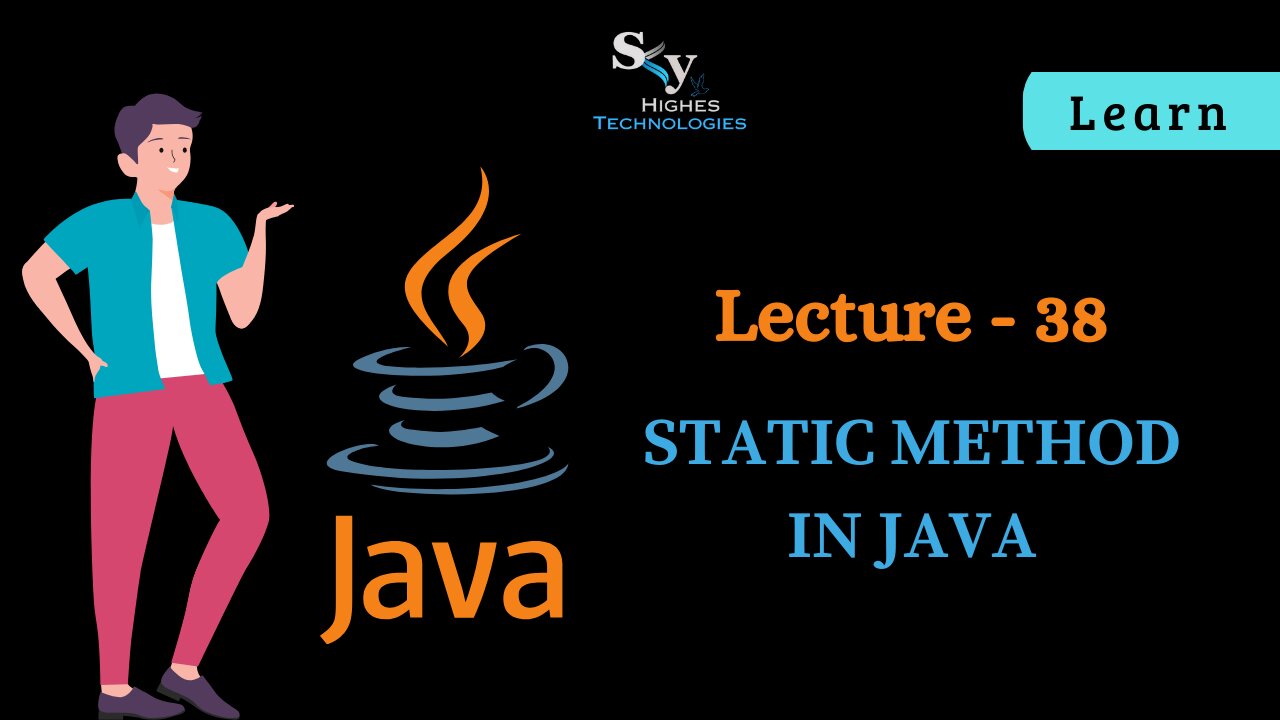Premium Only Content

#38 Static Method in JAVA | Skyhighes | Lecture 38
Here's a comprehensive explanation of static methods in Java:
What are static methods?
Class methods: They belong to the class itself, rather than individual objects of the class.
Called without object creation: You can invoke them directly using the class name (e.g., ClassName.staticMethod()).
Declared with static keyword: Use the static keyword to create a static method within a class.
Key characteristics:
Access to static members: Can only access static variables and call other static methods within the class.
No access to this keyword: Cannot use the this keyword to refer to the current object, as they don't operate on specific objects.
Memory allocation: Not allocated memory on the heap for each object, as they are associated with the class itself.
Example:
Java
class MathUtils {
public static double calculateArea(double radius) {
return Math.PI * radius * radius;
}
}
// Usage:
double circleArea = MathUtils.calculateArea(5.0);
Use code with caution. Learn more
Common uses:
Utility functions: Creating general-purpose functions that don't require object-specific data (e.g., mathematical calculations, string manipulations).
Factory methods: Creating objects without exposing the constructor, offering flexibility in object creation logic (e.g., Collections.emptyList()).
Singleton patterns: Ensuring only one instance of a class exists by making the constructor private and providing a static accessor method.
Accessing static variables: Manipulating static variables directly without object instantiation.
Best practices:
Use static methods for operations that don't require object state, enhancing code readability and maintainability.
Avoid using static methods excessively, as they can hinder testability and modularity.
Consider using dependency injection or other design patterns for object creation and interactions when appropriate.
Be mindful of thread safety when using static methods in multithreaded environments.
-
 37:44
37:44
Glenn Greenwald
15 hours agoGlenn On Tearing Down the Military Industrial Complex, Exposing Pro-Israel Indoctrination, and More | SYSTEM UPDATE #411
115K129 -
 4:04:20
4:04:20
Nerdrotic
15 hours ago $51.95 earnedAmazon Takes 007! Hollywood is Lost, Disney Cancels WHO? | Friday Night Tights 342 /w ItsAGundam
175K46 -
 43:27
43:27
Tucker Carlson
14 hours agoRay Dalio: America’s Hidden Civil War, and the Race to Beat China in Tech, Economics, and Academia
169K190 -
 56:56
56:56
Candace Show Podcast
14 hours agoEXCLUSIVE: Taylor Swift Will Be Deposed. | Candace Ep 150
206K158 -
 1:03:52
1:03:52
IsaacButterfield
11 hours ago $7.35 earnedRepublican Vs 25 Transgender Activists | Jewish Outrage | Lizzo Loses All the Weight
65.4K14 -
 1:10:23
1:10:23
Edge of Wonder
15 hours agoChinese Biochips Hacking Minds? Quantum Control & Journey Song Mandela Effect
86.1K9 -
 2:15:46
2:15:46
Quite Frankly
18 hours ago"Ghosts, Robotics, and OBE's" ft. Dr. Albert Taylor 2/21/25
78.7K18 -
 55:52
55:52
LFA TV
1 day agoMaking Germany Great Again | TRUMPET DAILY 2.21.25 7PM
52.5K9 -
 1:52:26
1:52:26
2 MIKES LIVE
14 hours ago2 MIKES LIVE #183 Open Mike Friday with Hannah Faulkner and Adelia Kirchner!
38.4K -
 12:09
12:09
MrBigKid
14 hours ago $3.24 earnedNew Mossberg 590R: Tactical Homestead Defender
43.3K7